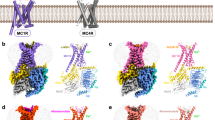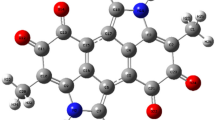Abstract
THE melanophore movement of the frog skin is a convenient slow motion model for the pharmacological receptor1–3. It has been shown that oxidizing agents, which have very low redox potentials, induce dispersion of melanophore, an effect similar to that of xanthines or hormones that stimulate melanophore. On the other hand, reduction or succinate cause melanophores to contract2. It was also shown that melanophore dispersion is accompanied by loss of energy, while for melanophore contraction energy must be supplied2,3.
This is a preview of subscription content, access via your institution
Access options
Subscribe to this journal
Receive 51 print issues and online access
$199.00 per year
only $3.90 per issue
Buy this article
- Purchase on SpringerLink
- Instant access to full article PDF
Prices may be subject to local taxes which are calculated during checkout
Similar content being viewed by others
References
Dikstein, S., Weller, C. P., and Sulman, F. G., Nature, 200, 1106 (1963).
Dikstein, S., Tal, E., and Sulman, F. G., Biochem. Pharmacol., 14, 1151 (1965).
Dikstein, S., and Sulman, F. G., Biochem. Pharmacol., 13, 819 (1964).
Sanadi, D. R., in The Enzymes (edit. by Boyer, P. D., Lardy, H. and Myrback, K.), 7, 307 (Academic Press, N.Y., 1963).
Ariese, P., Hohorst, H. J., and Bartels, H., Italian J. Biochem., 13, 308 (1964).
Author information
Authors and Affiliations
Rights and permissions
About this article
Cite this article
TAL, E., DIKSTEIN, S. & SULMAN, F. Function of Redox Systems in Melanophore Receptors. Nature 212, 851 (1966). https://doi.org/10.1038/212851a0
Issue date:
DOI: https://doi.org/10.1038/212851a0



